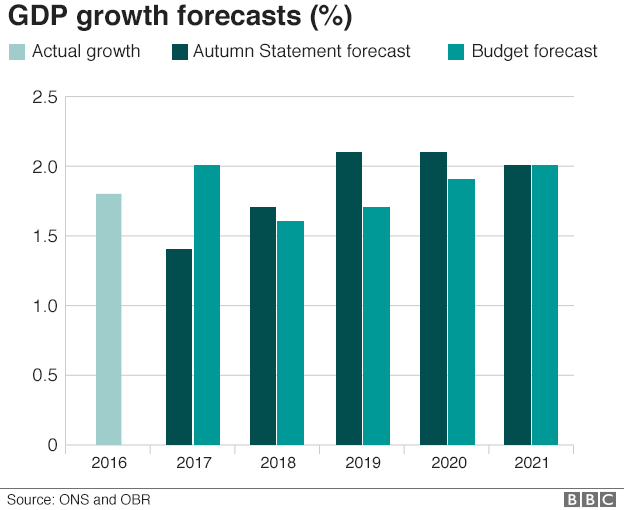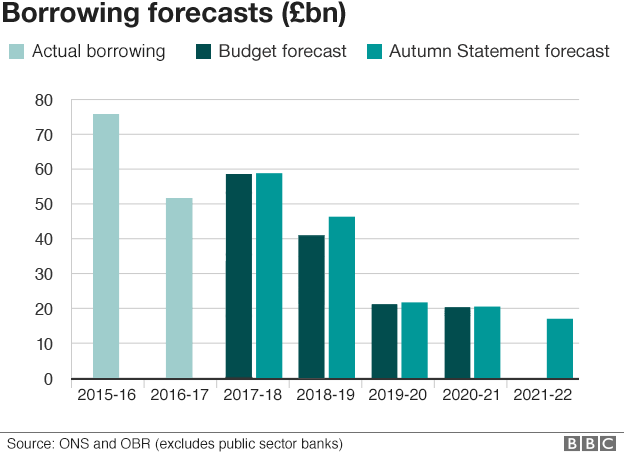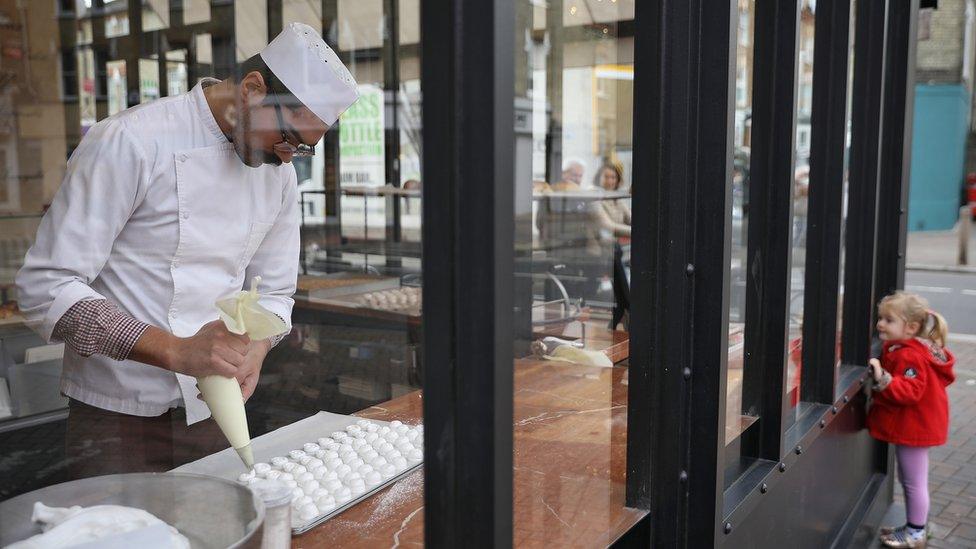UK growth forecast for 2017 revised up
- Published

The UK economy's growth forecast for this year has been revised sharply higher by the Budget watchdog.
The Office for Budget Responsibility, external now expects the economy to grow by 2%, up from its previous forecast of 1.4%.
However, growth is then expected to slow to 1.6% the following year, before gradually accelerating to 2% by 2021.
The OBR expects government borrowing for 2016-17 to be £51.7bn - a fall of £16.4bn from its November forecast and £4bn lower than the 2016 Budget figure.
By 2021-22 the deficit is forecast to fall to £16.8bn.
Government borrowing is expected to fall from 3.8% of GDP last year to 2.6% this year. The figure would then rise to 2.9% in 2018-19, but fall to 0.7% by 2021-22 - the lowest rate in two decades, according to the chancellor.


Philip Hammond said his Budget would "fund all additional spending decisions", and that would allow the government to avoid additional borrowing.
He said some had argued that lower government borrowing could permit higher spending, but he disagreed.
"Britain has a debt of nearly £1.7 trillion - almost £62,000 for every household in the country. Each year, we are spending £50bn on debt interest - more than we spend on defence and policing combined," he told MPs.
"And borrowing over the forecast period is still set to be £100bn higher than predicted at Budget 2016."
The OBR said: "The government remains on track to meet its targets for the structural deficit and public sector net debt.
"The government does not appear to be on track to meet its stated fiscal objective to 'return the public finances to balance at the earliest possible date in the next Parliament'."
'Substantial tightening'
The OBR also raised its forecast for inflation this year from 2.3% to 2.4%.
This figure was too conservative, said Rebecca Piggott, research fellow at the National Institute of Economic and Social Research, which expects CPI inflation to peak at about 3.7% at the end of this year.
"We think the OBR's projections for real income and consumer spending growth are too optimistic," Ms Piggott said.

The rate of CPI inflation is then expected to fall to 2.3% in 2018-19 - slightly lower than its previous forecast - and drop further to 2% in 2019.
Jonathan Loynes, chief economist at Capital Economics, said the OBR's caution had deprived Mr Hammond of an additional Brexit "war chest" that some had predicted.
"If we are right in expecting the economy to remain rather more resilient than the OBR expects, then public borrowing will clearly fall rather faster and give the chancellor more elbow room," he said.
"For now though, the big picture is still one of a substantial further tightening of fiscal policy over the coming years."

John Hawksworth, PwC chief economist, said Mr Hammond's reluctance to boost spending was understandable given the OBR made little change to its medium-term projections for either economic growth or public borrowing.
"Facing many economic and political uncertainties around Brexit and other geopolitical events, it was prudent for the chancellor to protect the £26bn headroom he left himself in meeting the new fiscal target he set out in the Autumn Statement," he said.
"But, given the OBR's view that the underlying economic position has not changed materially since November, the chancellor was not able to add to this headroom despite his cautious overall Budget judgement."
The OBR was implicitly assuming a soft Brexit, according to Samuel Tombs, chief UK economist at Pantheon Macroeconomics.
"The intensity of exports and imports, as well as immigration flows, are assumed to decline gradually, rather than falling sharply as they might after a hard Brexit. Like the OBR, we expect a soft Brexit, but the risks lie towards a worse outcome."